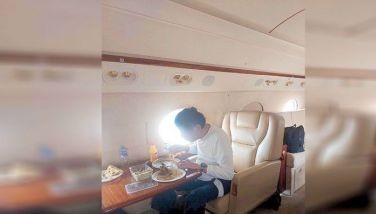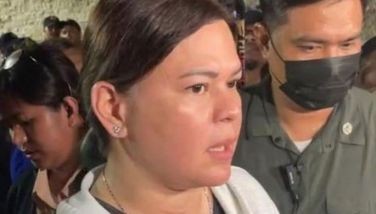Firm linked to Estrada got Metro garbage contract
January 29, 2001 | 12:00am
 (First of two parts)
(First of two parts)
A consortium associated with people close to ousted President Joseph Estrada allegedly enjoyed undue advantages that enabled it to corner a multibillion peso contract for the collection and disposal of some of Metro Manila’s garbage.
The government may have changed but Metro Manila’s garbage remains uncollected.
Even as the stench of uncollected refuse fills the streets of the capital, it is unlikely that the garbage problem will be resolved soon.
The problem, essentially, is political. Over the years, patronage, corruption and the use of political connections have exacerbated the garbage problem, not only in Metro Manila but in other parts of the country.
Last Sept. 28, the Pro-Environment Consortium (PEC) snagged a 25-year landfill contract worth $1.1 million a month or a total of $330 million for the entire period covered by the deal. Even by using an exchange rate of P47 to $1, this translates to a whopping total of P155 billion.
Save for a foreign partner  Rethman Recycling, reputedly the largest recycling and privately owned waste management company in the world  none of those involved in the PEC have previous hands-on experience in operating a landfill site or in solid waste management in general. In fact, the individuals that formed PEC do not have a track record in operating a multibillion-peso business.
What they had, however, were sterling connections to the presidential palace. The awarding of the landfill contract is the latest example of how waste management policy is determined not by environmental or health considerations, but mainly by political and pecuniary considerations.
PEC has four main investors, including Rethman Recycling. Another investor is the Environmental Dynamics Corp. (EDC), which has among its incorporators Frank Puzon, the personal pilot and high school classmate of Estrada at the Ateneo de Manila, and sugar trader Raul V. Gamban, a cousin of Guia Gomez, the former president’s mistress and mother of one of his sons, Joseph Victor or ‘JV.’
Gomez herself is not included in the company’s list of incorporators. But a former member of her inner circle says that about a week after the PEC won in a government bidding for a landfill contractor, she held a meeting with Puzon’s nephew and co-EDC incorporator, John Gabriel Puzon, and Raul Roberto de Guzman, Estrada’s nephew who was presidential consultant on the environment and water, at her Wynsum Tower office in Pasig City, allegedly to finalize plans for the project.
According to a waste management company official, it was no surprise that PEC was declared the winner over eight other firms in the bid for the contractor that would collect 2,000 tons of Metro Manila’s daily garbage and dump these in a sanitary landfill site. After all, says the businessman who wants to remain anonymous, PEC executives knew there would be such a bidding at least a year in advance, and were apparently privy to what would be required of the contractor.
The businessman says he knows this because he was approached by Gene Puzon, the councilor of Parañaque City who is Frank Puzon’s brother, to join PEC long before the bidding was announced, boasting that it was already a "done deal." He also quotes Puzon as saying that they were assured of landing the contract since Gomez was involved with them in the project. In fact, they had already gotten considerable help from officials of the Metro Manila Development Authority (MMDA) in crafting their proposal, the businessman recalls Puzon as saying.
"They knew about the landfill project long before the Greater Metro Manila Solid Waste Management Committee was going to be created," says the waste management executive, whose company did not join either PEC or the bidding. "They were already floating the project before anyone said the word ‘bidding’ and at a time when the MMDA had no money for this."
Estrada created the committee in August 1999 to formulate a solid waste management plan for Metro Manila and eight provinces surrounding it. The idea was to come up with concrete solutions on how to handle the 13,400 tons of trash generated each day by these areas. (Metro Manila, with its population of nearly 11 million, accounts for more than 6,000 tons of this total.)
Headed by former Presidential Flagship Programs and Projects director Secretary Roberto Aventajado, the waste management committee came up with, among other things, the Metro Manila Solid Waste Management Project, which aimed to dump a third of the metropolis’s daily trash into a sanitary landfill.
The committee issued the terms of reference (TOR) for the project in August 1999. This was approved four months later by the Metro Manila Development Council. Estrada himself gave the project a go-signal in January 2000, and solicitations for the proposals were first published on Feb. 13, 2000.
Yet the businessman notes that even during the first quarter of 1999, the Puzons were already busy inviting government officials and people involved in waste management to at least two elaborate presentations on landfills in a five-star hotel in Metro Manila. The executive remarks, "The presentations provided a great opportunity to pick the brains of officials involved in garbage and at the same time cement relationships with people who matter. Personal relationships are a factor in government contracts."
But he says that PEC had another ace up its sleeve: Early on, it knew how much it should bid because it had been given insider information on the government’s ceiling on the tipping fee, or the amount paid for every ton of trash thrown in a designated dumping site.
"The key is to know what the baseline figure is so you can go a lot lower," says the executive, who is familiar with the inner workings of the MMDA. "They were also told about what proposal the government would be most interested in, what the desired time frame is, and what the expectations are in terms of system efficiency."
According to the project’s TOR, each proponent had to submit its own proposed site and feasibility study for a sanitary landfill as part of the proposal. Evaluation of the proposal was also to be done in three stages: pre-qualification, technical and financial. But the Pre-qualification, Bids and Awards Committee (PBAC) would evaluate the technical proposals only of pre-qualified proponents and the financial proposals only of the technically qualified ones.
The pre-qualification and technical qualification alone  done on a "pass-fail" basis  had very stringent requirements. They stipulated, among others, that proponents already have with them a certificate of willingness to host a landfill from the host province, a certificate of willingness to host transfer stations, certification of site suitability from the Department of Environment and Natural Resources (DENR), Department of Agrarian Reform (DAR) exemption on conversion certificate, and an audited financial statement.
"These requirements certainly take time to accomplish so that anyone with no benefit of guidance would find it impossible to secure them right away,’’ observes the businessman. In fact, the process proved so time-consuming that of the 17 companies that purchased proposal documents for the project, only nine actually submitted proposals.
Of these nine, only PEC and Dizon-CGEA passed the technical evaluation stage. Three others  R-II Builders, Celdex-DM Consunji and Eurasian Company for Waste and Environment Service, Phils. Corp. (ECWES)  failed in the technical evaluation for having no bid security, no technical description of the proposed interim sanitary landfill and "inadequate preliminary design drawings to support narrative descriptions on project components."
John Gabriel Puzon admits that his family arranged the landfill presentations that had government officials in attendance, saying that they started holding these as early as 1998. But he denies that the PEC executives had prior knowledge of the project or of having received help from the MMDA.
According to Puzon, who considers Gomez’s son JV a good friend, PEC tried to get Gomez involved not because of her connections to Malacañang but because she was into recycling and environment projects. He says, "She never lifted a finger to help us." But, he adds, almost all the bidders had backers. "Kanya-kanyang padrino. Mabibigat ang kalaban namin. Kami lang ang mahina (Each had its own backer. Our rivals were heavyweights. Our company was the only weak one)."
Aventajado says the PEC eventually bested Dizon-CGEA with its bid of $18.89 per ton tipping fee for a landfill to be set up in Barangay Halayhayin in Pililla, Rizal, Dizon had offered a tipping fee of $32 per ton.
Aventajado does not deny that some of PEC’s incorporators are close to him and the President. But he says this did not figure in the bidding, which he described as being "above board." He also argues that Malacañang could not have played favorites since there were other similarly well-placed people whose companies participated in the landfill project.
The owner of R-II Builders, for instance, is construction mogul Reghis Romero, who was thrust in the limelight two years ago after he bought the Manila Times from the Gokongwei family. This was shortly after the newspaper got embroiled in a libel case filed by Estrada. It was later established that Romero, who has also been closely associated with Aventajado, had merely fronted for presidential pal Mark Jimenez.
Admittedly better-connected, however, was Jacinto Ng Sr., who, along with former Cavite Gov. Juanito Remulla, is associated with ECWES, which proposed a landfill in Magallanes, Cavite. Ng is one of Estrada’s longtime friends. He and one of his companies appear as owners of two mansions in Wack-Wack, Mandaluyong City that have been linked to presidential mistress Laarni Enriquez.
"If you look at the ownership of the companies who lost, you can see there was really transparency because how would a Jack Ng lose in a situation like this?" says Aventajado.
Ironically enough, PEC itself is now dropping hints that there were irregularities in the awarding last December of two two-year contracts for interim controlled dumpsites, which differ from open dumpsites in that the trash is leveled and then covered with soil. One contract went to Waste Action Recycling (WAR), a group that PEC claims did not even bid for the planned dumpsite in Mariveles, Bataan. The other went to a consortium made up of R-II Builders, DM Consunji and Celdex, for a similar set-up in Semirara, Antique.
PEC says while it took the PBAC seven months to conduct the bidding for the sanitary landfill, it took only nine days for it to decide on these two contracts, which will cost the government a total of $51.1 million in the two years that they will be in effect.
Aventajado, however, denied that any irregularity took place. He and Flagships Undersecretary Manuel Gaite also deny allegations that some MMDA and committee officials  including themselves  profited from any of the waste contracts awarded. Aventajado does admit having received calls from "persons" asking him to decide favorably on a certain company. He insisted, though, that he never acted on these requests.
He said PEC had even been given "first crack" at the contracts, having won the landfill bid. But Aventajado said it had proposed a tipping fee of $20.40 per ton for the interim dumpsite, while the others had offered $19 per ton. He also said the MMDA had no choice but to sign the contracts post-haste or else "we will all drown in garbage."
Part of this is because the PEC has yet to be formally awarded the landfill contract after a temporary restraining order (TRO) was issued by the Pasig regional trial court. The TRO was requested by the Australia-based Jancom Environmental Corporation and Generale des Eaux of France, which claimed they had already been awarded a $350- million contract to build an incinerator by the administration of former President Fidel Ramos. The Court of Appeals has ruled in favor of Jancom, but the MMDA, through the Solicitor General’s Office, has filed a motion for reconsideration.
This impasse, said Aventajado, contributed to "an emergency situation" that had been brought about by the closure of the San Mateo landfill, as well as the shutdown of the two other dumpsites for Metro Manila trash. The Carmona dumpsite has been closed since 1998 while Payatas was shut down last July.
But the solution chosen by the committee is proving hard to implement, with residents in Mariveles and Semirara opposing the setting up of dumpsites in their respective communities. The government has all but given up on dumping Manila’s trash on Semirara, following a very public outcry over the plan.
Antiqueños point to the fragile ecosystem of Semirara island, which is surrounded by coral reefs and is a sanctuary for tortoise, dolphins, tiger sharks and other rare and endangered species. They cited the danger of the garbage washing up and down the shores of surrounding islands.
Mariveles, Bataan Mayor Angel Peligorio, meanwhile, has said that the MMDA’s decision was "illegal" because his town had not issued a resolution showing it was willing to host the project.
There is no telling if the residents of Pililla, Rizal where PEC says it will be putting its sanitary landfill, would be more accommodating than the people of Mariveles and Semirara. Then again, Greenpeace Southeast Asia regional director Von Hernandez points out, "No province or community should be made as a toxics sacrifice zone for the disposal of garbage mainly generated in the country’s urban centers."
Concern for profits and the preference for shortcuts, however, seem to be hindering contractors and officials from considering other alternatives. Says Hernandez: "(The government) has always relied on quick fixes and magic bullets. We’re not saying that the problem can be solved overnight. The thing is, if we have to decide on what model we’re going to adopt, let us think of one that will take us to the right direction." - (Philippine Center for Investigative Journalism)
BrandSpace Articles
<
>
- Latest
- Trending
Trending
Latest




















